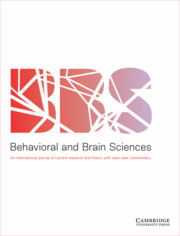Article contents
How to learn about teaching: An evolutionary framework for the study of teaching behavior in humans and other animals
Published online by Cambridge University Press: 23 May 2014
Abstract
The human species is more reliant on cultural adaptation than any other species, but it is unclear how observational learning can give rise to the faithful transmission of cultural adaptations. One possibility is that teaching facilitates accurate social transmission by narrowing the range of inferences that learners make. However, there is wide disagreement about how to define teaching, and how to interpret the empirical evidence for teaching across cultures and species. In this article I argue that disputes about the nature and prevalence of teaching across human societies and nonhuman animals are based on a number of deep-rooted theoretical differences between fields, as well as on important differences in how teaching is defined. To reconcile these disparate bodies of research, I review the three major approaches to the study of teaching – mentalistic, culture-based, and functionalist – and outline the research questions about teaching that each addresses. I then argue for a new, integrated framework that differentiates between teaching types according to the specific adaptive problems that each type solves, and apply this framework to restructure current empirical evidence on teaching in humans and nonhuman animals. This integrative framework generates novel insights, with broad implications for the study of the evolution of teaching, including the roles of cognitive constraints and cooperative dilemmas in how and when teaching evolves. Finally, I propose an explanation for why some types of teaching are uniquely human, and discuss new directions for research motivated by this framework.
Information
- Type
- Target Article
- Information
- Copyright
- Copyright © Cambridge University Press 2015
References
- 224
- Cited by



Target article
How to learn about teaching: An evolutionary framework for the study of teaching behavior in humans and other animals
Related commentaries (38)
Another way to learn about teaching: What dogs can tell us about the evolution of pedagogy
Childhood and the evolution of higher-effort teaching
Clarifying the range of social-cognitive processes subserving human teaching
Cognitive mechanisms matter – but they do not explain the absence of teaching in chimpanzees1
Cognitive universals and cultural variation in teaching
Cooperation in human teaching
Cultural variant interaction in teaching and transmission
Does all teaching rest on evolved traits?
Evolutionary mechanisms of teaching
Eyes on the price: Human culture and its teaching
Human teaching and learning involve cultural communities, not just individuals
Is tolerance really teaching?
Learning about teaching requires thinking about the learner
Learning in and about opaque worlds
Measuring teaching through hormones and time series analysis: Towards a comparative framework1
Mind, brain, and teaching: Some directions for future research
More examples of chimpanzees teaching
Multiple dilemmas of help and counteraction to teaching in complex social worlds
On the persistent gray area between teaching and punishment
Play to learn, teach by play
Robot teachers: The very idea!
Subjectivity may hinder the application of Kline's teaching framework in comparative contexts
Systematic data are the best way forward in studies of teaching
Teacher and learner: Supervised and unsupervised learning in communities
Teaching as an exaptation
Teaching interactions are based on motor behavior embodiment
The active role played by human learners is key to understanding the efficacy of teaching in humans
The benefits of an evolutionary framework for the investigation of teaching behaviour: Emphasis should be taken off humans as a benchmark
The lowest common denominator between species for teaching behaviors
The mutual relevance of teaching and cultural attraction
The parental brain: A neural framework for study of teaching in humans and other animals
The proximate-ultimate confusion in teaching and cooperation
The study of teaching needs an inclusive functional definition
To what adaptive problems is human teaching a solution?
Understanding teaching needs development
Variations in teaching bring variations in learning
What is teaching? A clear, integrative, operational definition for teaching is still needed
“Teaching is so WEIRD”
Author response
Much to learn about teaching: Reconciling form, function, phylogeny, and development